NCERT Exemplar Solutions: Transportation in Animals & Plants | Science Class 7 (Old NCERT) PDF Download
| Table of contents |

|
| Multiple Choice Questions |

|
| Very Short Answer Questions |

|
| Short Answer Questions |

|
| Long Answer Questions |

|
Multiple Choice Questions
Q.1. The muscular tube through which stored urine is passed out of the body is called –
(a) kidney
(b) ureter
(c) urethra
(d) urinary bladder
Ans: c
Explanation:
Waste which is present in the blood has to be removed from the body. This is done by the blood capillaries in the kidneys. The wastes dissolved in water are removed as urine. From the kidneys, the urine goes into the urinary bladder through tube-like ureters. It is stored in the bladder and is passed out through the urinary opening at the end of a muscular tube called the urethra. The kidneys, ureters, bladder and urethra form the excretory system.
Q.2. They are pipe-like, consisting of a group of specialized cells. They transport substances and form two-way traffic in plants. Which of the following terms qualify for the features mentioned above?
(a) Xylem tissue
(b) Vascular tissue
(c) Root hairs
(d) Phloem tissue
Ans: d
Explanation:
Phloem tissue consists of a group of specialized cells. Sieve tubes are elongated tubular conducting channels of phloem through which food is transported. The contents of phloem can move in the upward as well as in the downward direction. Therefore, they form two-way traffic in plants.
Q.3. The absorption of nutrients and exchange of respiratory gases between blood and tissues takes place in –
(a) veins
(b) arteries
(c) heart
(d) capillaries
Ans: d
Explanation:
Capillaries are the extremely thin blood vessels where an exchange of substances and absorption of nutrients take place. Their thin walls facilitate the exchange.
Q.4. In which of the following parts of the human body are sweat glands absent?
(a) Scalp
(b) Armpits
(c) Lips
(d) Palms
Ans: c
Explanation:
Sweat glands are responsible for the production of sweat. These glands are absent in lips hence lips don’t secrete sweat.
Q.5. In a tall tree, which force is responsible for pulling water and minerals from the soil?
(a) Gravitational force
(b) Transportation force
(c) Suction force
(d) Conduction force
Ans: c
Explanation:
Roots absorb water and minerals from the soil continuously. Evaporation of water from leaves creates a suction force which causes the water to move upwards.
Q.6. Aquatic animals like fish excrete their wastes in gaseous form as
(a) Oxygen
(b) Hydrogen
(c) Ammonia
(d) Nitrogen
Ans: c
Explanation:
Oxygen is expelled out by plants, Hydrogen is a cellular waste product, Nitrogen is excreted in the form of urea and the organisms which excrete urea is called as ureotelic organisms. Aquatic animals will excrete waste products in the form of ammonia gas which dissolves in water and these organisms are known as ammonotelic animals.
Very Short Answer Questions
Q.1. Veins have valves which allow blood to flow only in one direction. Arteries do not have valves. Yet the blood flows in one direction only. Can you explain why?
Ans: Arteries have thick, elastic walls, and blood flows rapidly at high pressure due to the pumping action of the heart, ensuring one-directional flow. Valves are absent in arteries because the pressure is sufficient to prevent backflow.
Q.2. What is the special feature present in a human heart which does not allow mixing of blood when oxygen-rich and carbon dioxide-rich blood reach the heart?
Ans: The human heart is four-chambered, with a septum separating the left side (oxygen-rich blood) and right side (carbon dioxide-rich blood), preventing their mixing.
Q.3. Name the organ which is located in the chest cavity with its lower tip slightly tilted towards the left.
Ans: Heart
Short Answer Questions
Q.1. Look at Figure 11.1. Draw another figure of the same set-up as would be observed after a few hours.

Ans:

Q.2. Arrange the following statements in the correct order in which they occur during the formation and removal of urine in human beings.
(a) Ureters carry urine to the urinary bladder.
(b) Wastes dissolved in water is filtered out as urine in the kidneys.
(c) Urine stored in the urinary bladder is passed out through the urinary opening at the end of the urethra.
(d) Blood containing useful and harmful substances reaches the kidneys for filtration.
(e) Useful substances are absorbed back into the blood.
Ans:
(d) Blood containing useful and harmful substances reaches the kidneys for filtration.
(e) Useful substances are absorbed back into the blood.
(b) Wastes dissolved in water is filtered out as urine in the kidneys.
(a) Ureters carry urine to the urinary bladder.
(c) Urine stored in the urinary bladder is passed out through the urinary opening at the end of the urethra.
Q.3. Paheli uprooted a rose plant from the soil. Most of the root tips, with root hairs, got left behind in the soil. She planted it in a pot with new soil and watered it regularly. Will the plant grow or die? Give a reason for your answer.
Ans:
- Root hairs, essential for water and nutrient absorption, were mostly left behind.
- Without them, the plant struggles to take up water and nutrients, likely causing it to die.
- It may grow if new roots develop quickly from the stem or remaining roots with regular watering.
Q.4. (a) Name the only artery that carries carbon dioxide-rich blood.
(b) Why is it called an artery if it does not carry oxygen-rich blood?
Ans:
a. Pulmonary artery
b. It is called an artery because it carries blood away from the heart.
Q.5. Boojho’s uncle was hospitalised and put on dialysis after a severe infection in both of his kidneys.
(a) What is dialysis?
(b) When does it become necessary to take such a treatment?
Ans:
a) Dialysis is periodical filtering of blood through an artificial kidney
b) Dialysis is done when kidney fails to function.
Q.6. Name the process and the organ which helps in removing the following wastes from the body.
(a) Carbon dioxide
(b) Undigested food
(c) Urine
(d) Sweat
Ans:

Q.7. Observe the Figure and answer the given questions:

(a) Name the instrument.
(b) Label the parts A, B and C.
Ans:
The given instrument is a stethoscope.

Q.8. Paheli noticed water being pulled up by a motor-pump to an overhead tank of a five-storeyed building. She wondered how water moves up to great heights in the tall trees standing next to the building. Can you tell why?
Ans:
Roots absorb water and minerals from the soil continuously. Evaporation of water from leaves creates a suction force which causes the water to move upwards.
Long Answer Questions
Q.1. Match the parts of the heart in Column I with the direction of flow of blood in Column II.

Ans:

Q.2. Read the following terms given below.
Root hairs xylem urethra
arteries kidneys veins
atria capillaries heart
ureter phloem urinary bladder
Group the terms on the basis of the categories given below.
(a) The circulatory system of animals.
(b) Excretory system in human.
(c) Transport of substances in plants.
Ans:
(a) The circulatory system of animals- arteries, atria, capillaries, veins, heart.
(b) Excretory system in human-ureter, kidneys, urethra, urinary bladder.
(c) Transport of substances in plants-root hairs, xylem, phloem.
Q.3. Fill in the blanks of the following paragraph using just two words – arteries and veins.
___(a)___ carry oxygen-rich blood from the heart to all parts of the body and ___ (b)___ carry carbon dioxide-rich blood from all parts of the body back to the heart. ___ (c)___ have thin walls and __ (d)___ have thick elastic walls. Blood flows at high pressure in ___ (e)____. Valves are present in __ (f) ___ which allow blood to flow only towards the heart. __ (g)___ divide into smaller vessels. These vessels further divide into extremely thin tubes called capillaries. The capillaries join up to form ____ (h)_____.
Ans:
a) Arteries carry oxygen-rich blood from the heart to all parts of the body and b) veins carry carbon dioxide-rich blood from all parts of the body back to the heart. c) Veins have thin walls and d) arteries have thick elastic walls. Blood flows at high pressure in e) arteries. Valves are present in f) veins which allow blood to flow only towards the heart. g) Arteries divide into smaller vessels. These vessels further divide into extremely thin tubes called capillaries. The capillaries join up to form h) veins.
Q.4. While learning to ride a bicycle Boojho lost his balance and fell. He got bruises on his knees and it started bleeding. However, the bleeding stopped after some time.
(a) Why did the bleeding stop?
(b) What would be the colour of the wounded area and why?
(c) Which type of blood cells is responsible for clotting of blood?
Ans:
a. The bleeding stopped due to formation of blood clots.
b. Dark red due to clotting of blood.
c. Platelets are responsible for clotting of blood.
|
111 videos|286 docs|28 tests
|
FAQs on NCERT Exemplar Solutions: Transportation in Animals & Plants - Science Class 7 (Old NCERT)
| 1. What is the process of transportation in animals and plants? |  |
| 2. How does transportation in animals occur? |  |
| 3. How do plants transport water and nutrients? |  |
| 4. What is the role of stomata in transportation in plants? |  |
| 5. How is oxygen transported in animals? |  |
















